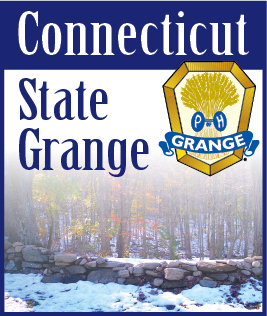| SEPTEMBER 21, 2013 -- Each time someone picks up a copy of the Connecticut Granger newspaper, the official publication of the Connecticut State Grange, they see a photo of a World War II military plane on the masthead. What the reader may not realize, is that the plane pictured was named the “Connecticut Granger” after the efforts of Connecticut Grange members to support the war through its War Bond program.
During World Wars I and II, the U.S. government issued war bonds for the purpose of financing military operations. War bonds not only generated capital, but also made civilians feel as if they were involved with the operations.
In the 1940s, President Franklin D. Roosevelt along with Secretary of the Treasury Henry Morgenthau, Jr. enacted a voluntary loan system, which began the Defense War Bond program during World War II. Bonds were sold for as little as $18.75 and matured in 10 years, paying the bond holder $25. Over the course of World War II, 85 million Americans purchased bonds totaling over $185 billion.
As incentive to sell War Bonds, the government instituted the “Buy-a-Bomber” appreciation campaign to name a “Flying Fortress” Boeing B-series plane for every $300,000 in War Bonds sold by a group or organization. Select Boeing B-17 planes were used to conduct War Bond tours as part of the program.
The Boeing B-series Flying Fortress planes were heavy-duty military machines. The B-17 was the most famous, and one of the most successful airplanes built during its time. The B-17 received the name “Flying Fortress” from a newspaper reporter in Seattle who commented on its defensive firepower. Boeing soon after patented the name for their planes.
Sherman K. Ives, Master of the Connecticut State Grange, instituted a state-wide effort in August 1943, with Grange members across Connecticut selling War Bonds. Bake sales, dinners, and programs of all sorts were held in Grange Halls across the state to raise money for the war efforts.
In the book “The Grange in Connecticut” written by Lida Skilton Ives, she explains:
“Connecticut Grange support for the war effort was varied and substantial. The greatest achievement was the raising of $487,000 worth of War Bonds during the Third War Loan Drive. In recognition, the War Department named one of its flying fortresses, “Connecticut Granger.”
The Connecticut State Grange effort was started at Wichita Grange in Warren, who rallied their small town of 328 people and sold $12,075 in war bonds. Mystic Grange topped the Granges in the state with a sales total of $58,263. Each Grange who participated in the effort received a commemorative photo of the Connecticut Granger Flying Fortress.
The Connecticut Granger newspaper was started in 1960 by George Arundell and Maud Haines of Farmill River Grange, under State Master Robert K. Mitchell. The efforts to get the newspaper off the ground once again saw Connecticut Grange members working together for a common goal, similar to that of the War Bond campaign years earlier.
2000 subscribers were necessary for the newspaper to be viable, so Arundell and Haines formed a committee who then traversed the state to secure subscribers. They traveled 3,764 miles and spoke to 2,994 people at 12 Pomona meetings and 28 Subordinate Grange meetings. Their subscription goal was met in 6 weeks time, attending 6-7 meetings per week.
When it came time to decide on a name for the new official publication, “Connecticut Granger” was chosen due to the combined efforts of Grange members statewide, making the newspaper a reality. The inaugural issue of the paper featured a photo of the Connecticut Granger Flying Fortress prominently on its front page.
In 1943, the Connecticut State Grange played a major role in the War effort by participating in the War Bond program. In 1960, Grange members rallied together to start the Connecticut Granger newspaper. These two initiatives shared a common goal: Community Granges across Connecticut not only rose to, but exceeded the challenges they faced.
Sources:
Ives, Lida Skilton (1953). “The Grange in Connecticut”
Newspaper: Connecticut Granger, Glastonbury, Connecticut (1960, Vol 1. No.1). Article: “Connecticut Granger” (page 1).
Newspaper: The Daily Chronicle, Centralia, Washington (February 3, 1944). Article: “Granges Busy in War Effort” (page 11).
Sparrow, J.T. (2008). “Buying our boys back”: The mass foundations of fiscal citizenship in World War II. Journal of Policy History” |
